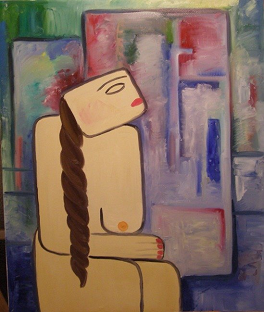Holiday for plaits By Usam Baysayev, special to Prague Watchdog
Samashki, Chechen Republic
In August, following a recently established tradition, Chechnya enters a busy holiday season. No sooner has one holiday sped noisily by than another is upon us: at the end of this week we will celebrate Chechen Women’s Day. The republic has been hung with brightly-coloured baubles like a Christmas tree, and in the evenings each Chechen home is witness to a fit of incurable epilepsy on the local television channels. The theatrically-staged performances usually begin at the strictly appointed hour, the scripts almost unchanged from one year to the next. The presenter reads some rubbishy verses about loyalty to the state in imitation of the Soviet radio announcer Yuri Levitan, and a host of singers of both sexes trip the light fantastic in some silly and cheerful dance.
As an appetizer we shall have the opportunity of enjoying the sight of senior officials handing out awards as if they were dispensing pardons to sinners. There will also be jolly competitions – testimony to the creative imagination of their authors and organizers. The government’s information and analysis department has announced its intention of measuring the length of the plaits of local female residents. Nearly 700 contestants have already taken part in the qualifying round. The final results have not yet been announced, but among the participants an exceptional joie de vivre was demonstrated by an 85-year-old Grozny woman. Not a bad age – and over all those years of Soviet power the stately matron seemed to have managed, may Allah forgive her, to grow a considerable head of hair...
But no one in Russia is afraid of hair. Measuring its length is a sort of national sport. In Krasnoyarsk last year there was a contest that went by the name of "Long Plaits are a Maiden’s Glory". This April a similar tournament was held in Tula. The winner, who over a span of twenty years had grown a plait of hair five feet long, received a bunch of flowers and a free season ticket for the sauna. And as we Chechens are now proper Russians, we are united with the great motherland not only by the harshness of everyday life but also by delights in the form of beauty contests and other events that are no less exotic for the Islamic part of the North Caucasus.
To all of this I am starting to grow accustomed, and I have no strong objections. The questions arise in connection with the dubious nature of the holiday’s ideological content. Much has been written in the Chechen press during recent days about the heroism and sacrifice of Chechen women. The textbook example is the tragic story of Dady-Yurt. Let me recall the outline of those distant events. Just 190 years go, on September 15, 1819, the Chechen village of Dady-Yurt was subjected to assault and destruction on the orders of Russia's General Yermolov. Most of the villagers were killed in the fighting, and those who survived were mainly women. The women were taken captive and an attempt was made to smuggle them to the other side of the Terek. But many preferred death to life in captivity. Pulling along the Russian soldiers who were guarding them, the women threw themselves into the swift mountain torrent. And now in Grozny there is to be a monument to all those women who died. The work’s sculptural composition will portray their achievement.
It is probably groundless, but I have been tormented by a vague suspicion: isn’t this glorification of women who were responsible for the deaths of Russian soldiers a direct canonization of Islamic martyrdom? If we are to be truthful, then firstly we must admit that the women of Dady-Yurt committed suicide. Secondly, the women pulled into the raging torrent, and from there straight to the next world, soldiers of the glorious Russian army who considered their captives a legitimate trophy. There can be little doubt that the women's actions were motivated by a savage hatred of the civiliser, and by an unworthy desire to avenge the killing of the villagers and their families. And thirdly, I think no one will dispute the fact that those women were Muslims, and that before they made their self-sacrifice they uttered the Shahada*. When translated into modern terms, this suggests an excess of religious fanaticism.
How do the upcoming celebrations relate to what happened at Dady-Yurt? For the residents of that village did not fight for "the integrity of Russia" – quite the opposite, in fact. They can hardly have had a connection with the ongoing events in Chechnya today – except that the women who threw themselves into Terek had long, plaited hair, covered by large headscarves. That was the tradition in those days, and it had nothing to do with any contests.
* Shahada (Arabic) - “testimony”): the Muslim declaration of belief in the oneness of God and acceptance of Muhammad as his prophet.
Picture: synews.ru. (Translation by DM) (P,DM)
DISCUSSION FORUM
|

